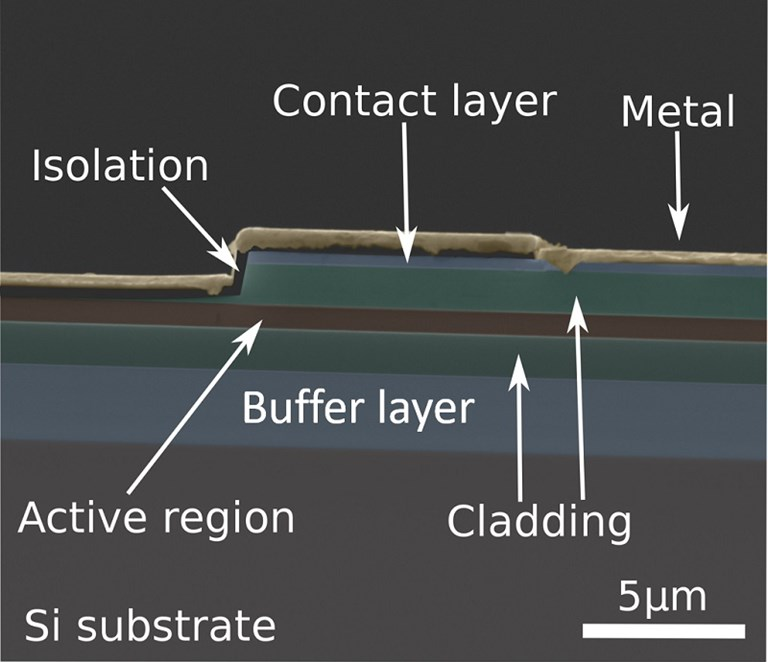Mar 27 2020
Scientists have built high-performance mid-infrared laser diodes directly on silicon substrates that are compatible with microelectronics—the first-ever achievement made so far.
 Researchers have fabricated the first set of mid-infrared laser diodes directly on microelectronics-compatible silicon substrates. The image on the bottom shows the various layers of the laser in a close-up of the section marked in the top image. Image Credit: Eric Tournié, University of Montpellier.
Researchers have fabricated the first set of mid-infrared laser diodes directly on microelectronics-compatible silicon substrates. The image on the bottom shows the various layers of the laser in a close-up of the section marked in the top image. Image Credit: Eric Tournié, University of Montpellier.
The novel lasers could lead to an extensive development of economical sensors for precise, real-time environmental sensing for applications such as food safety analysis, air pollution monitoring, and sensing leakages in pipes.
Most optical chemical sensors are based on the interaction between the molecule of interest and mid-infrared light. Fabricating mid-infrared lasers on microelectronics-compatible silicon can greatly reduce their cost because they can be made using the same high-volume processing techniques used to make the silicon microelectronics that power cell phones and computers.
Eric Tournié, Research Team Leader, University of Montpellier
The latest fabrication method has been illustrated in Optica, The Optical Society’s (OSA) journal intended for high-impact research.
The study was done at the EXTRA facilities and as part of the REDFINCH consortium, which is creating portable, miniaturized, inexpensive optical sensors to detect chemicals in both liquids and gases.
For this project, we are working upstream by developing photonic devices for future sensors. At a later stage, these new mid-infrared lasers could be combined with silicon photonics components to create smart, integrated photonic sensors.
Eric Tournié, Research Team Leader, University of Montpellier
Industry-Compatible Fabrication
Laser diodes are composed of semiconductor materials that turn electricity into light. Now, a type of semiconductor called III-V can be used to create mid-infrared light. For nearly 10 years, the scientists have been trying to deposit III-V semiconductor material on silicon using a technique called epitaxy.
Although the scientists had earlier used lasers on silicon substrates, those substrates were not adaptable with industry standards for the fabrication of microelectronics. When using industry-matching silicon, variances in the material structures of the III-V semiconductor and silicon lead to the formation of defects.
A particular defect called an anti-phase boundary is a device killer because it creates short-circuits. In this new work, we developed an epitaxial approach that prevents these defects from reaching the active part of a device.
Eric Tournié, Research Team Leader, University of Montpellier
The scientists also enhanced the process that is used to produce the laser diode from the epitaxial material. Consequently, they were able to produce a whole laser structure on an industry-matching silicon substrate with a single operation of an epitaxial tool.
High-Performance Lasers
The team demonstrated the latest method by creating mid-infrared laser diodes that worked in continuous-wave mode and displayed low optical losses. Now, the scientists have planned to analyze the lifetime of the novel devices and how that lifetime is associated with the fabrication as well as operation mode of the devices.
The researchers further stated that once their technique is completely developed, epitaxy of lasers on bulk silicon substrates (up to 300 mm across) using silicon microelectronics tools will enhance the regulation of the fabrication process; this will, consequently, further decrease the laser fabrication costs and help design innovative devices.
In addition, the new lasers could even be integrated with CMOS technology or passive silicon photonics integrated circuits to produce highly sensitive, small, economical, smart photonic sensors for liquid and gas measurements.
“The semiconductor material we work with allows fabrication of lasers or photodetectors operating in a broad spectral range, from 1.5 microns (telecom band) to 25 microns (far infrared). Our fabrication method can be applied in any field where one needs to integrate III-V semiconductors on silicon platforms. For example, we have already fabricated quantum-cascade lasers emitting at 8 microns by applying this new epitaxial approach,” concluded Tournié.